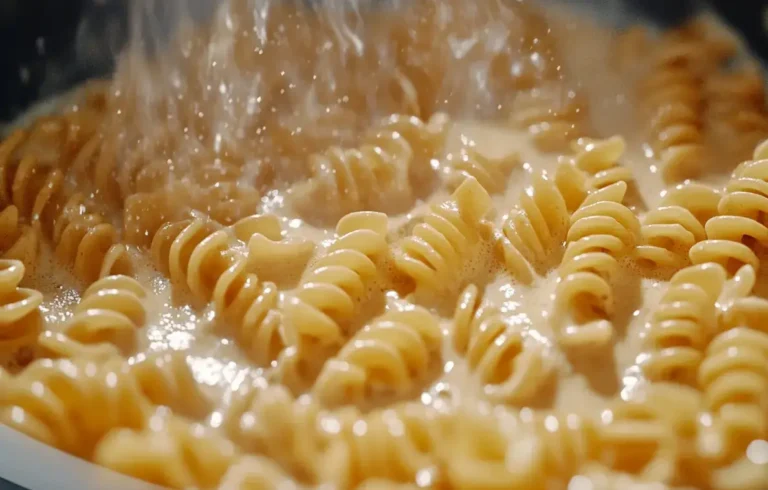Best Ways to Store and Reheat Creamy Pasta
When it comes to creamy pasta, enjoying leftovers can be just as satisfying as the first time around—if done right. Knowing the best ways to store and reheat creamy pasta is essential to avoid dry, split sauces or mushy pasta. With the right methods, you can preserve the rich texture and flavors of your dish, ensuring every bite is just as creamy and delicious as the original. Whether you’re storing pasta in the fridge or reheating it for the next day, these tips will help you achieve perfect results every time.
Creamy pasta dishes are beloved for their rich, luscious sauces that cling to every bite of pasta, creating a comforting and satisfying meal. However, storing and reheating creamy pasta can be tricky. If not done correctly, the sauce can split, leaving you with an oily mess rather than a silky, smooth dish. Whether you’re working with Alfredo, carbonara, or any other cream-based sauce, the techniques for storing and reheating creamy pasta are crucial for maintaining both flavor and texture. In this guide, we’ll cover the best methods for storing and reheating creamy pasta so that your leftovers taste as good as they did when freshly made. We’ll explore how to keep the sauce from splitting, how to reheat it without drying out, and the best practices for freezing if you want to save your pasta for later. If you’re looking for a detailed breakdown of different reheating methods, check out How to Reheat Pasta with Cream Sauce for expert tips on keeping your pasta creamy and delicious.
Why Creamy Pasta Requires Special Attention When Reheating
Reheating pasta with a creamy sauce presents some unique challenges. The key reason is that most cream sauces are emulsions, which means they are a mixture of fat and water. When exposed to heat, this delicate balance can easily break, causing the sauce to split. This is when the fat separates from the liquid, resulting in an unpleasant texture with pools of oil instead of a smooth sauce. Too much heat can be the enemy of creamy sauces, and finding the right method to reheat pasta gently is essential. Another issue arises because pasta absorbs moisture. When you store creamy pasta, the pasta continues to soak up the sauce, leaving you with a drier dish when you take it out of the fridge. This means you need to reintroduce some liquid during the reheating process to restore the creamy texture. For example, adding milk or water to the sauce while reheating can help to stabilize the emulsion and bring back that creamy consistency. To ensure your creamy pasta reheats beautifully, consider using methods that allow for gentle, even heating. These include techniques like reheating on the stove with milk or using a double boiler. For more specific tips on avoiding split sauces, check out Substitutes for Heavy Cream in Pasta for ideas on improving sauce stability.
Best Practices for Storing Creamy Pasta
When it comes to creamy pasta, proper storage can make a significant difference in how well your leftovers reheat. Follow these best practices to ensure that your creamy pasta stays fresh and flavorful.
1. Refrigerating Creamy Pasta
The best way to store creamy pasta is to keep it in an airtight container in the refrigerator. Here are a few essential tips:
- Store Separately: For the best results, try to store the pasta and sauce separately. This prevents the pasta from absorbing too much of the sauce, which can cause the pasta to become soggy and the sauce to dry out.
- Use an Airtight Container: Seal your pasta in an airtight container to prevent it from drying out or absorbing other odors from the fridge.
- Refrigeration Time: Creamy pasta can last for up to four days in the fridge. However, it’s best to consume it within 2-3 days for optimal taste and texture.
2. Can You Freeze Creamy Pasta? Pros and Cons
Freezing creamy pasta can be tricky due to the nature of cream-based sauces. However, it’s possible to freeze your pasta with the right preparation.
- Pros of Freezing: Extends the shelf life of your leftovers. Convenient for meal prepping or saving larger portions for later.
- Cons of Freezing: Cream-based sauces tend to separate when frozen and reheated. This is due to the changes in texture caused by freezing. The pasta may become mushy when thawed if not handled properly.
Freezing Tips
- Cool Completely: Before freezing, let the pasta cool to room temperature. This prevents condensation from forming, which could lead to freezer burn.
- Store in Portions: Divide the pasta into portions before freezing. Smaller portions reheat more evenly.
- Use Freezer-Safe Containers: Ensure that your containers are tightly sealed and freezer-safe to avoid any frost from forming on the pasta.
Reheating Methods for Creamy Pasta
Reheating creamy pasta correctly can bring your leftovers back to life. Below are some of the best methods for reheating creamy pasta, ensuring that the sauce remains smooth and the pasta stays tender.
1. Reheating Creamy Pasta on the Stove
Reheating pasta on the stove is one of the most reliable ways to maintain its creamy texture. Here’s how to do it:
- Step 1: Heat a few tablespoons of milk, water, or cream in a shallow pan. You’ll want about 2-3 tablespoons per portion of pasta.
- Step 2: While the liquid is heating, microwave the pasta for 5-10 seconds to help loosen it.
- Step 3: Add the pasta to the heated liquid, stirring constantly. The sauce should start to re-emulsify and regain its creamy texture.
- Step 4: Once the pasta is heated through and the sauce is smooth, remove it from the heat and serve immediately.
This method is highly effective because it uses gentle heat and reintroduces liquid to the sauce, helping to prevent splitting.
2. Reheating Creamy Pasta Using a Double Boiler
If you want to avoid overheating your pasta, using a double boiler is an excellent choice. This method heats the pasta slowly and gently, reducing the risk of splitting.
- Step 1: Fill a saucepan with 2-3 inches of water and bring it to a simmer.
- Step 2: Place a heat-safe bowl over the saucepan, making sure the bottom doesn’t touch the water.
- Step 3: Add your leftover pasta and a tablespoon of milk, water, or cream to the bowl. Stir frequently until the pasta heats through and the sauce loosens up.
This method is particularly effective for more delicate cream-based sauces that are prone to separating when exposed to direct heat.
3. Reheating Creamy Pasta in the Microwave
Reheating pasta in the microwave can be convenient, but it requires extra care to avoid drying out or splitting the sauce.
- Step 1: Place a portion of the pasta in a microwave-safe bowl. Add a tablespoon of milk or water to help loosen the sauce.
- Step 2: Cover the bowl with plastic wrap or a damp paper towel to create steam, which helps to retain moisture.
- Step 3: Microwave the pasta at 50% power in 20-second intervals, stirring between each interval. Continue this process until the pasta is heated through.
While the microwave isn’t the ideal reheating method for creamy pasta, it can work in a pinch if you monitor it closely and stir frequently to prevent the sauce from separating.
Oven Reheating for Creamy Pasta
Reheating creamy pasta in the oven is best for larger portions or pasta bakes. Although it takes longer, this method is less likely to dry out the pasta if done correctly.
- Step 1: Preheat your oven to 350°F (180°C).
- Step 2: Place the pasta in a shallow baking dish. Add a few tablespoons of milk or water and stir it into the pasta to maintain moisture.
- Step 3: Cover the dish with aluminum foil to trap steam and bake for 10-20 minutes, depending on the portion size. Stir halfway through and add more liquid if needed.
- Step 4: For extra flavor, uncover the dish in the last 2-3 minutes and sprinkle with cheese before baking until bubbly.
This method works well for dishes like baked ziti or creamy mac and cheese. However, be cautious with time, as the oven can dry out smaller portions of creamy pasta.
Creative Reheating Methods for Creamy Pasta
If you’re feeling adventurous, there are some more creative ways to reheat creamy pasta:
1. Stir-Frying Creamy Pasta
- Method: Chop the pasta into smaller pieces and stir-fry in a hot pan until crispy on the edges. This creates a different texture, transforming the creamy pasta into something more unique and flavorful.
- Downside: The sauce will no longer be creamy, but the dish will have a crispy, fried texture that can be enjoyable.
2. Turning Creamy Pasta into a Frittata
- Method: Mix the leftover pasta with beaten eggs and cook in an ovenproof skillet. Transfer the skillet to the oven to finish cooking the frittata.
- Result: This turns the leftover pasta into a new meal with a custardy texture, perfect for breakfast or brunch.
For more creative leftover ideas, check out Things to Serve with Frittatas.
FAQs on Storing and Reheating Creamy Pasta
How do I store creamy pasta to keep it from drying out?
To keep creamy pasta from drying out, store it in an airtight container in the fridge. For best results, store the sauce and pasta separately, if possible.
What is the best way to reheat creamy pasta without it separating?
The best way to reheat creamy pasta is on the stove with a few tablespoons of added liquid, such as milk or water. Stir continuously to help the sauce re-emulsify and regain its creaminess.
Can you freeze creamy pasta without ruining the texture?
While you can freeze creamy pasta, the texture may change due to the cream sauce. To minimize separation, freeze the pasta in smaller portions and thaw it slowly in the fridge before reheating gently on the stove.
Why does my cream sauce always split when reheating?
Cream sauces split because the fat and water separate when overheated. Using gentle heat and adding liquid during the reheating process helps to stabilize the sauce and prevent splitting.
Is it better to store the sauce and pasta separately?
Yes, storing the sauce and pasta separately can help maintain the texture of both components. The pasta won’t absorb as much sauce, and the sauce will stay creamier for longer.
How long does creamy pasta last in the fridge?
Creamy pasta lasts up to four days in the fridge, but it’s best to eat it within 2-3 days for the freshest flavor and texture.
How can I reheat pasta in the microwave without drying it out?
To prevent pasta from drying out in the microwave, add a tablespoon of liquid and cover the bowl with plastic wrap or a damp paper towel. Heat in short intervals, stirring frequently.
Conclusion: Storing and Reheating Creamy Pasta Like a Pro
Properly storing and reheating creamy pasta ensures that you can enjoy your leftovers without losing the delicious texture and flavor of the original dish. Whether you choose to reheat on the stove, in the oven, or in the microwave, the key is to add extra liquid and heat gently to maintain the creaminess of the sauce. Experiment with different reheating methods based on the equipment you have available, and don’t be afraid to get creative with how you use your leftovers. By following these tips, you can transform your creamy pasta leftovers into a meal that tastes just as good as when it was first made.

